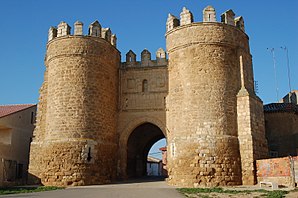Villalpando (Spain)
| Villalpando municipality | ||
|---|---|---|
 Villalpando - Puerta de la Villa
|
||
| coat of arms | Map of Spain | |

|
|
|
| Basic data | ||
| Autonomous Community : |
|
|
| Province : | Zamora | |
| Comarca : | Tierra de Campos | |
| Coordinates | 41 ° 52 ′ N , 5 ° 25 ′ W | |
| Height : | 690 msnm | |
| Area : | 126.92 km² | |
| Residents : | 1,475 (Jan 1, 2019) | |
| Population density : | 11.62 inhabitants / km² | |
| Postal code : | 49630 | |
| Municipality number ( INE ): | 49250 | |
| administration | ||
| Website : | Villalpando | |
Villalpando is a small town and capital of a municipality ( municipio ) with 1,475 inhabitants (as of January 1, 2019) in the province of Zamora in the autonomous community of Castile and León . The city was and is of great historical and cultural importance.
location
The small town of Villalpando is located by the Río Valderaduey at an altitude of about 690 m above sea level. d. M. The provincial capital Zamora is about 52 km (driving distance) to the southwest; the small town of Toro is just under 50 km to the south. The climate in winter is quite cold, but in summer it is warm to hot; the scant rainfalls (approx. 400 mm / year) fall throughout the year.
Population development
| year | 1857 | 1900 | 1950 | 2000 | 2016 |
| Residents | 3.223 | 3.165 | 2,777 | 1,731 | 1,528 |
The sharp population decline is mainly due to the mechanization of agriculture and the associated loss of jobs.
economy
Agriculture has always played the most important role for the population of the region; the small town was formerly an important market town and a center for handicrafts, trade and services of all kinds.
history
For a long time, Villalpando was regarded as Intercatia , the capital of the Celtic Vaccaeans who settled in the area, as passed down by ancient authors - a hypothesis that has since become obsolete. The area was later settled by Romans and Visigoths . Conquered by the Moors in the 8th century , the area north of the Duero was recaptured by Asturian-Leonese armies as early as the 9th century ( reconquista ) . In a document produced during the reign of Ramiros II (r. 931–951), the place name Villa Alpández can be found for the first time . At the end of the 10th century, the Moorish military leader Almansor temporarily wiped out the Christian successes, but in the 11th century the Kingdom of León expanded its territory again to the Duero border. In the year 1211 King Alfonso IX handed over . (r. 1188–1230) the city already fortified by the Knights Templar under his predecessors ; in the year of his death, the Kingdom of León was united with the Kingdom of Castile . In the 14th century the city fell to the Duke of Frías as a fief . From 1526 to 1528, the sons of the French King Francis I were temporarily held hostage in the city's Alcázar.
Attractions
- The city's landmark is the Puerta de la Villa (or Puerta de San Andrés ), a city gate with stone heraldic shields built in the 14th century from broken stone and stone . The laterally projecting round towers with loopholes and battlements are impressive .
- The choir of the three-aisled Iglesia de Santa María de Antigua was built in the Mudejar style entirely from stacked brick - blind arcades from the 13th century . Unfortunately, the rest of the church has been in ruins since 1933.
- The Church of San Nicolás de Bari was built in the 12th century, but was rebuilt in the Mudejar style in the 13th century. In the 18th century, the old artesonado ceiling of the nave was replaced by a vault. Most of the church collapsed in 1989, but it was reconstructed in 1992–1996.
- The single nave Iglesia de San Pedro was also built in the 12th century; It is also ruinous - all windows and doors are walled up.
- The rectangular Plaza Mayor ( approx. 2000 m²) in the center underscores the former size and importance of the city. Sometimes bullfights still take place on it.
- The Convento de San Antonio de Padua , built in 1633, still belongs to the Order of the Poor Clares . A renaissance portal adorned with coat of arms, but generally rather inconspicuous , leads into a large inner courtyard.
Important personalities
- Gaspar de Borja y Velasco (1580–1645), Archbishop of Seville (1632–1645) and Toledo (1645)
literature
- Luis Calvo Lozano among others: Parroquias, Archivos y Cofradías de Villalpando. Centro de Estudios Benaventanos 2003, ISBN 978-84-920047-8-2 .
Web links
Individual evidence
- ↑ Cifras oficiales de población resultantes de la revisión del Padrón municipal a 1 de enero . Population statistics from the Instituto Nacional de Estadística (population update).
- ^ Villalpando - map with altitude information
- ↑ Villalpando - climate tables
- ^ Villalpando - population development
- ^ Villalpando - history
- ^ Villalpando - Church of Santa María la Antigua
- ^ Villalpando - Church of San Nicolas de Bari
- ^ Villalpando - Iglesia de San Pedro
- ^ Villalpando - Iglesia de San Pedro

